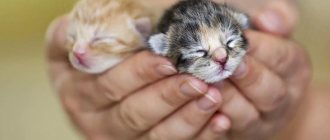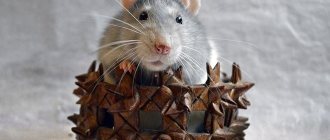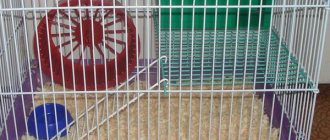So, have you decided that pet rats are for you? Now the big question is, should you choose males or females? When it comes to preferences, some people are strong supporters of one gender or the other.
We believe that both male and female rats have their own strengths and weaknesses, which are best understood from the beginning. To help you decide, we'll cover the differences and reasons why both sexes make great pets. And also about how to determine the sex of a rodent.
What kind of domestic rodents exist: list of species, how long do they live at home?
Pet rodents
Pet rodents are deservedly popular. Small furry animals are funny, cute and relatively unpretentious - they are easier and more economical to keep than a cat or dog. There are several types of rodents that are suitable for living at home. Here is the list:
- Common hamsters
- Djungarian hamsters
- Guinea pigs
- Decorative rabbits
- Chinchillas
- Gerbils
- Rats, etc.
Decorative rats occupy not the last place among pet rodents. They are distinguished by intelligence, affection and learning ability, as well as greater cleanliness than is commonly thought.
Difficulties in keeping rodents can arise due to their need to sharpen their teeth. Rodents are rodents: they love to taste everything, even wires. Disadvantages include the low life expectancy of animals at home. If guinea pigs can live 6-8 years , then rabbits and chinchillas can up to 15 years . The lifespan of other small rodents is about 3 years . This also applies to decorative rats. When choosing a pet (especially for a child), you need to keep this in mind to avoid future stress.
Features of birth
After the baby is 3–3.5 weeks old, the owner can pick him up. Rodent breeders note that the more often you hold them in your arms, the more affectionate and obedient they will become. The key is to not overdo it. You need to know when to stop everything. Excessive affection is a factor in the development of stress in a pet. You should not separate the mother from the babies for a month. The immune system of newborn rat pups is directly dependent on how long they will be around it.
The total growth period for rat pups is one year. As for nutritional features, after a month you can add cottage cheese, boiled chicken bones, apples, milk corn, and bananas to their diet. There are also a number of foods that should not be included in the diet of baby rats. These are yolk, broccoli, salads, cucumber, liver, tomatoes.
Experts in breeding animals of the rodent family advise adhering to the above recommendations at least until the baby rats reach three months.
The small animal is a defenseless creature that needs special careful care and maternal attention. The attitude of owners towards an animal should be the same as towards their child.
Domestic decorative rats: gender differences in appearance
Male and female house rats are equally cute and fluffy, but differ slightly in appearance. The main indicators are size, body shape and coat properties. Gender differences in appearance are described below.
Male rats by :
- Larger size and weight
- Quite hard, dense wool
- Pear-shaped body structure
The distinctive features of a girl rat are:
- Smaller body size compared to males
- Elongated torso
- Silky, smooth and shiny fur
In addition to appearance, an important criterion for owners is the smell. Males smell stronger, mainly due to their habit of marking territory. However, with good care you can reduce it to a minimum.
Immediately or later?
The thought “I want to get a rat” has been visiting you for a long time, and are you thinking about getting two rats at once? Then it's better to do it right away. After all, you can immediately take two babies from one litter, especially since they are inexpensive.
If the rats have known each other since childhood, they will move to a new home together without any problems and subsequently live together in harmony, without acute conflicts. Moreover, pups of the same litter are the same age, which means they will spend almost their entire lives next to each other.
If one rat is older, say, by a year, then there is a high probability that the youngest will someday be left alone. Unfortunately, the life of a rat is short-lived; domestic animals live only one and a half to three years, and even a year for a rat is a large part of its life.
However, if the decision to get a second rat came to you already when the first one had settled in and felt like a mistress, there is no need to be upset. With a competent approach to one rat, you can add a friend - you just need to treat this responsibly. By the way, there is a separate article on this topic on the site: How to make two rats friends?
Your little rats may not spend their entire lives together, but they will still be together. This is still better than having a social and affectionate animal live alone.
And in conclusion, we note one more important tip in case you want two rats to appear in your house at once. Rats must be of the same sex! Love will certainly happen between people of different sexes at puberty, and close family ties in the absence of other partners will not stop them. And this love will bear fruit - often, in large quantities and regularly. And frequent births will not add health to the mother rat, especially since parents from the same store can easily turn out to be close relatives - which will affect the health of the offspring. In addition, you will have to constantly think about how to accommodate the baby rats.
Accordingly, it will be better for everyone if you take two boys or two girls into your home, rather than a couple in love. Decorative rats can manage without erotic relationships, but it’s harder just without communication.
The women's magazine "100 Worlds" wishes you that your rats are healthy and prosperous, that they live happily and for a long time!
Or maybe you already have two pet rats running around the house happily?
Tell us about your fun family in the comments!
Anastasia Cherkasova, lover of decorative rats
Return to the site section: ANIMALS
The behavior of decorative rats: how does it differ between boys and girls?
Decorative rats
Babies of decorative rats show almost no gender differences in behavior. They appear as the animal matures. How is it different for boys and girls?
The greatest inconvenience can be caused by teenage males ( 6-8 months ):
- Due to age-related changes, they become aggressive, and not only towards their relatives, but also towards humans. Although this is a temporary condition, it should not be forgotten, especially if there are children at home.
- Adult male rats are usually calm, phlegmatic and affectionate.
- They love to sit on their owner and enjoy being scratched.
- To keep them, a spacious cage with room for houses and hammocks is desirable, as these animals love to swing.
Rats are social animals, so it is recommended to keep them in same-sex pairs. However, a fight for leadership may flare up between a pair of males. To avoid competition between animals, it is necessary to take rat pups of the same age and litter. However, male rats easily tolerate loneliness if the owner pays them enough attention.
Important: Due to their calmness and low mobility, male rats are prone to obesity, so try not to overfeed the animal.
Female rats:
- Active, mobile and curious.
- They have no hierarchy, and the girl friends form a conflict-free couple.
- They love to play with each other and with various objects.
- You can put toys in their cage and provide them with holes and tunnels.
- Females are also more clean and tidy, and when properly kept, they have virtually no odor.
- The activity of female rats requires more attention to them - curious animals will try everything, and when walking they can run away.
Important: Female rats are prone to mammary tumors. This problem can be solved in advance by sterilizing the animal. If you are keeping a rat for breeding, monitor its health and promptly contact a veterinarian.
Differences between adult rats
Gender characteristics in adult rats are much more pronounced than in babies. Therefore, distinguishing a female from a male will not be difficult.
By external signs
First of all, the body parameters of domestic rats indicate their gender. Boys are much larger, they are stocky, squat, and quite strongly built.
In the direction from the neck to the tail, the body of males gradually expands. Girls are more compact and graceful, their torso has a uniform oblong shape. The following characteristic features will also help identify the gender of your pet:
- The main feature of adult males is the large testes located at the base of the tail. It is simply impossible not to notice them. When purchasing a pet rat from a pet store, you should not lift the animal by the tail for inspection. In this position, the testicles in boys go inside the body and distinguishing them from girls becomes problematic. Also, the testes hide at low ambient temperatures (below +15-16°C).
- In adult females, the double row of nipples, in addition to what has been preserved since birth, becomes more pronounced. But in males the papillae are not visible.
- coat . The fur of females is smooth, silky - very pleasant to the touch.
- By the color of the tail . In growing males it is orange-pink in color. Females are usually white, off-white or beige. Also, a pattern in the form of circles may be observed on the tail. For boys it is pink, for girls it is white.
As a rule, once pet rats reach 2-3 months of age, questions about gender do not arise. It's enough to just look under the animal's tail.
By behavior and character
The personalities of female and male domestic rats vary greatly. The main distinctive character traits will tell you about belonging to one gender or another:
- Boys love a slow lifestyle. They are calmer and more leisurely. They prefer privacy in the house to active games. Girls, on the contrary, are sociable and are distinguished by their desire to learn everything new. They are active, mobile, and love to frolic.
- Females are more aggressive, especially during pregnancy and when nursing offspring. Sensing danger, the female may bite the offender or scare him away with a warlike squeal. Males generally avoid conflict. The only exception is fights for a place in the hierarchy. When an alpha male is identified, conflicts instantly cease.
- Males are strongly attached to the owner and other family members. They love to spend time with people, caress, love to be petted. Females are more freedom-loving, they go into the hands only when they themselves want it. It is believed that boys are more loyal and, with good treatment and care, absolutely trust their owner.
- Females are considered smarter than males. They remember their owner faster, get used to their nickname and respond to it, can be trained with a clicker, and adapt more easily to new living conditions. It takes much longer to train males.
It is worth noting that each decorative rat, regardless of gender, has an individual character. Sometimes it happens that boys behave very actively, and girls are distinguished by a meek disposition.
There is also an opinion that female fluffies are more clean: they eat carefully, constantly wash their fur and go to the toilet in a certain place. However, this is not quite true. Males are not inferior to females in their love of cleanliness and also constantly take care of themselves.
How to determine the sex of a baby rat?
Determining the sex of a baby rat
Males and female domestic rats are distinguished, like all animals, by gender. How to determine the sex of a baby rat?
- To do this, you need to hold the rat in your palm with its tail down, carefully holding its head. You can carefully turn the animal onto its back.
- Signs of a male are testicles under the tail, absence of nipples and a significant ( about 6 mm ) distance from the anus to the urethra .
- Females , accordingly, have a double row of mammary glands on the abdomen, no testicles, and the distance from the urethra to the anus is smaller - about 3 mm .
Important : Do not hold a rat by the tail under any circumstances - this is a lot of stress for the animal. Carry out the inspection carefully and carefully.
Growth and development of babies
Little rats grow very quickly. In the first week of life, they gain 3 g of weight every day. Babies actively suck mother's milk, which has high nutritional value. It contains almost 9% protein, the same amount of fat and 4% lactose.
In the first days of their lives, rat pups are constantly near their mother. She moves them from place to place to warm everyone with her body. Small animals do nothing but eat and sleep. On the second day, hungry babies may begin to make a barely audible squeak. Approximately 4 days after birth, the ears of rat pups rise. Now they can hear.
Already on the 4-5th day of life, you can determine what color the little rat pups will have. In light-colored rat pups, the skin remains pink, while in dark-colored pups, it acquires a grayish tint. During this period, the first soft fluff appears on the body.
At the age of one week, baby rats' incisors begin to emerge. The molars will appear no earlier than in 3 weeks. In some individuals they grow only on the 35-40th day of life.
The rate of tooth growth depends on the individual characteristics of the animal and diet.
One of the most significant periods in the life of little rats is the time when their eyes open. This occurs 14-17 days after birth. At first a small gap appears between the eyelids, but after a couple of days the babies begin to see.
From this moment on, the little rats become more active and begin to crawl out of the nest. They look around with great curiosity, go around every corner of the cage, learn to wash themselves and clean their fur. By the way, by this time it has already completely grown back. Between the 15th and 20th days of life, females develop nipples.
At 3 weeks of age, the pups look like their adult counterparts. Their body length reaches 14-15 cm, but the tail is still short. At 25 days the animals become completely independent. Females are already capable of becoming pregnant, but this is undesirable, since the body is not yet fully formed and strengthened. The development of rat pups continues until they are one year old.
Description of the rodent
— Advertising —
The body length of the rat is from 8 to 30 cm, the length of the tail is either the same as the body length or exceeds it, weight depending on the species is from 40 to 400 g. The body color is predominantly dark gray or gray-brown, yellow is also found , red and orange tones. The toes are very flexible.
Etymology of the name
In the scientific world, the name of the gray rat sounds like Rattus norvegicus. It appeared after a biologist from England, John Berkenhout, saw these animals in the port and wrote a description of them. He was sure that ships arrived in England only from Norway, so with a clear conscience he dubbed the species he “discovered” the Norwegian rat, although these rodents did not exist in that country at all at that time. And they arrived in Foggy Albion, most likely, from Denmark and could well have become Danish rats if Sir Berkenhout had a little better understanding of navigation. Pasyuk, or Patsyuk, is another of their names, familiar to many Russians, Ukrainians and Belarusians. So, what are the heroes of our article?
Nicknames for the smart ones
Every pet is the smartest for its owner, this is not discussed. But if a baby stands out among his brothers and sisters almost from birth, then he is clearly an intellectual.
The following names are suitable for a smart boy:
- Aristotle;
- Smart ass;
- Brain;
- Dodger;
- Windows;
- Connoisseur;
- Indigo;
- Charlatan;
- Socrates;
- Rector;
- Brainy;
- Prodigy;
- Univer.
And for smart girls:
- Smart girl;
- Clever;
- Dogma;
- Umka;
- Thought;
- Axiom;
- Plutisha;
- I was thinking.
Smart and good appetite
Popular names
If popular nicknames come to mind first, then most likely you should choose one of them. It is advisable that the nickname be short, 2-3 syllables. This will make it easier for the rat to remember the sound of its name. Rodents hear nicknames with the consonants “sh”, “ch”, “g” better.
List of beautiful and commonly used names for Dumbo boy rats:
- Toshka;
- Zhora;
- Semyon;
- Baloo;
- Pif;
- Ken;
- Filya;
- Gosha;
- Sally;
- Spot;
- Bambino;
- Flick;
- Tank;
- Chuk;
- Pat;
- Kurt;
- Game;
- Grandfather;
- Guf;
- Steele;
- Gong;
- Jim;
- Dave;
- Ben;
- Puddy;
- Chubchik;
- Mickey Mouse;
- Kutya;
- Cake;
- Vano;
- Elf;
- Golf;
- Coconut;
- Fatty is a food lover;
- Yasha.
Rat Dumbo Sergio
The most common names for girl rats:
- Lucy;
- Sonya;
- Molly;
- Tasha;
- Barbie;
- Laura;
- Dina;
- Rollie;
- Evie;
- Lucky;
- Masya;
- Bead;
- Java;
- Asya;
- Yana;
- Button;
- Cherry;
- Bonya;
- Zoya;
- Mayan;
- Nina;
- Viola;
- Doll;
- Yula;
- Nyasha;
- Martha;
- Veta;
- Mary;
- Pushinka;
- Manechka;
- Zita;
- Lisa;
- Courtney;
- Rita;
- Dora.
Interesting fact!
Dumbo rats were developed about 30 years ago. This happened in America. They did not get to Russia right away; more than 10 years passed.
They got their name due to their appearance. The big ears reminded the creators of a baby elephant from the famous cartoon.











